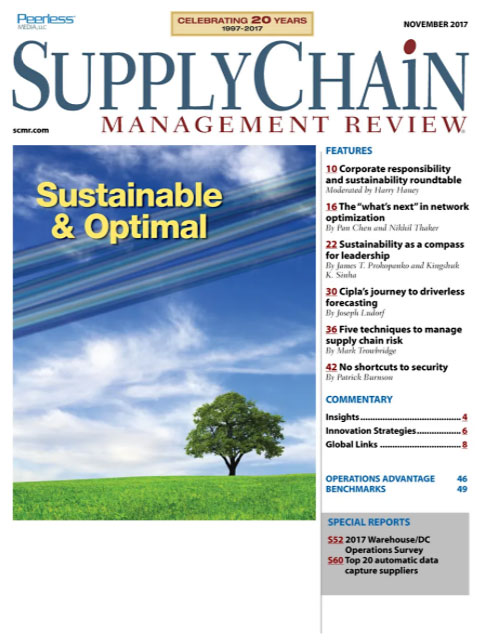Sorry, but your login has failed. Please recheck your login information and resubmit. If your subscription has expired, renew here.
November 2017
There are strands of sustainability and corporate responsibility through much of this month’s issue. James T. Prokopanko, the former CEO and president of The Mosaic Company, details how corporate responsibility became his compass for leader ship when he took over the reins of the company back in 2007. Similarly, Joseph Ludorf, the executive director of supply chain for Cipla Medpro, details how revamping the planning process enables the South African pharmaceutical company to prof- itably supply drugs to underserved populations on the continent as part of its corporate mission. We round out the issue with five tips for intelli- gent risk taking in… Browse this issue archive.Need Help? Contact customer service 847-559-7581 More options
Months before the infamous malware attack known as “Petya” hit Maersk, Fedex and other logistics companies in June, commercial insurer Allianz Global Corporate & Specialty (AGCS) warned logistics and supply chain managers that breaches in cyber security were of utmost concern. As stated in its annual “Safety & Shipping Review 2017,” the threat of cyber attacks continues to be real—and quite significant.
Prior to the Petya event, most violations of proprietary data had been aimed at breaching corporate security rather than taking control of a vessel or plane. Fortunately, the response by a handful of high-tech shipping specialists kept the episode from becoming a global catastro¬phe. For logistic managers, the lesson learned is that mitigating risk in this arena now needs to be a primary and ongoing goal.
“Many more enhancements to existing legacy IT networks are essen¬tial,” says Captain Andrew Kinsey, senior marine risk consultant at AGCS.
Safety-enhancing technology is already making an impact on ship¬ping—from electronic navigational tools to shore-based monitoring of machinery and crew welfare. Technology has the potential to signifi¬cantly reduce both the impact of human error—which AGCS analysis shows accounted for approximately 75% of the value of almost 15,000 marine liability insurance claims over five years, equivalent to more than $1.6 billion—as well as machinery breakdown.

This complete article is available to subscribers only.
Log in now for full access or start your PLUS+ subscription for instant access.
SC
MR
Sorry, but your login has failed. Please recheck your login information and resubmit. If your subscription has expired, renew here.
November 2017
There are strands of sustainability and corporate responsibility through much of this month’s issue. James T. Prokopanko, the former CEO and president of The Mosaic Company, details how corporate responsibility… Browse this issue archive. Download a PDF file of the November 2017 issue.Months before the infamous malware attack known as “Petya” hit Maersk, Fedex and other logistics companies in June, commercial insurer Allianz Global Corporate & Specialty (AGCS) warned logistics and supply chain managers that breaches in cyber security were of utmost concern. As stated in its annual “Safety & Shipping Review 2017,” the threat of cyber attacks continues to be real—and quite significant.
Prior to the Petya event, most violations of proprietary data had been aimed at breaching corporate security rather than taking control of a vessel or plane. Fortunately, the response by a handful of high-tech shipping specialists kept the episode from becoming a global catastrophe. For logistic managers, the lesson learned is that mitigating risk in this arena now needs to be a primary and ongoing goal.
“Many more enhancements to existing legacy IT networks are essential,” says Captain Andrew Kinsey, senior marine risk consultant at AGCS.
Safety-enhancing technology is already making an impact on ship¬ping—from electronic navigational tools to shore-based monitoring of machinery and crew welfare. Technology has the potential to significantly reduce both the impact of human error—which AGCS analysis shows accounted for approximately 75% of the value of almost 15,000 marine liability insurance claims over five years, equivalent to more than $1.6 billion—as well as machinery breakdown.
SC
MR


Latest Supply Chain News
Latest Podcast

 Explore
Explore
Software & Technology News
- Nine questions are the key to AI success in building resilient supply chains
- Looking back at NextGen 2024
- AI is moving omnichannel closer to the customer
- How technological innovation is paving the way for a carbon-free future in logistics and supply chains
- Körber Supply Chain Software’s Craig Moore says MercuryGate acquisition is about the customer
- Robotic use grows by 10%
- More Software & Technology
Latest Software & Technology Resources

Subscribe

Supply Chain Management Review delivers the best industry content.

Editors’ Picks






